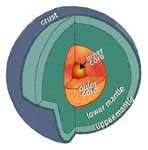 |
This image displays the most fundamental layers of Earth's interior:
the chemically unique crust, mantle and core. The silicate rock mantle is
compresses to a more dense rock due to a phase transition at 660 km depth. This
depth marks the division between the upper and lower mantle. Earth's iron core also
has further subdivisions: the outer core is molten and the inner core is solid. Seismologists
have detected further layering in Earth, such as at the bottom 200-300 km of the mantle,
called the D" layer (not pictured). |
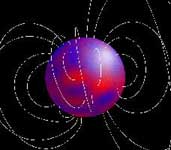 |
The magnetic field viewed at the core surface. This image
has been generated from a mathematical computer model derived
from satellite observations of the magnetic field taken by
the satellite Magsat in 1980. The core radius is only 3485
km, roughly half that of the Earth's radius. Blue contours
indicate the strength of the radial magnetic field entering
the core surface, and red contours the strength of the radial
field exiting the core surface., and white lines are actual
field lines. The picture clearly shows the tilt of the
magnetic field away from the rotation axis of the earth by
about 10 degrees. This is the major ingredient of the field's
deviation from axisymmetry; this lack of axisymmetry is an
essential part of dynamo theory, the theory describing how
the magnetic field is recreated over time, and is what makes
the subject so difficult. |
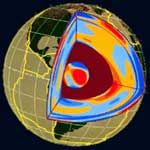 |
In this cutaway of Earth, variations in the seismic velocity are depicted by warm (lower seismic
wavespeeds) or cool (high seismic wavespeeds) colors (courtesy of A. Dziewonski & coworkers).
Large scale patterns of heterogeneity are present, and correlate geographically
with features at Earth's surface. Lower velocities are seen beneath mid-ocean ridges,
high velocities are detected beneath regions of past or present subduction. |
 |
Fast ("cold") and slow ("hot") anomalies in the mantle, as imaged by seismic tomographic
model SB4L18 (G. Masters, G. Laske, H. Bolton, A. Dziewonski, in Mineral Physics and Seismic
Tomography, S. Karato et al. eds, AGU, Washington DC, 2000). (a) Looking from the south, with the
CMB at the bottom of the image and the surface at the top of the image, downwelling slabs (blue)
appear to sink to the CMB in most areas. Two large megaplumes (red) are observed underneath Africa
(left of image) and the Pacific (center of image). (b) Looking down from above, the pattern of
continents and oceans is clearly visible. Contoured velocity values are 0.6% fast (blue) and 1% slow (red). |
 |
This image shows a high pressure apparatus, whereby materials are pressurized in
multi-anvil hydralic press. |
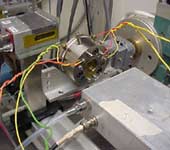 |
This image shows the diamond anvil cell apparatus used by the
Cornell Mineral Physics. In using the principle
of Pressure=Force/Area, scientists squeeze materials to extremely high pressures via a
very small sample area. Diamonds are well-suited as anvils to compress the sample to be
studied -- they are the hardest material on Earth, and they are transparent to light. Thus
lasers can be used to shine through the diamond anvils to heat the sample to temperatures
of the Earth's deep interior. Studies using these type of experiments compliment seismic
studies as we attempt to bridge the gap between the shapes and sizes of seismic velocity
patterns (imaged from seismology) and their possible chemical composition. |
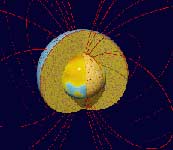 |
This cutaway shows the magnetic field
lines due the Earth's magnetic field generated in the molten outer core. The
positive and negative polarity portions of the field are shown as either orange or blue.
Half of the core shows the
strength of the radial field (blue and yellow being opposite polarities),
the other half shows the tangential component of the fluid velocities which
are responsible for maintaining the field and for generating the secular
variation (the change in the magnetic field with time).
The "geodynamo" process has maintained the field for almost
the entire life of the Earth, four and a half billion years. |
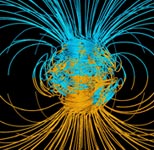 |
A snapshot of the 3D magnetic field structure simulated with the
Glatzmaier-Roberts geodynamo model. Magnetic field lines are blue where
the field is directed inward and yellow where directed outward.
The rotation axis of the model Earth is vertical and through the center.
A transition occurs at the core-mantle boundary from the intense,
complicated field structure in the fluid core, where the field is generated,
to the smooth, potential field structure outside the core. The field
lines are drawn out to two Earth radii. Magnetic field is wrapped around the
"tangent cylinder" due to the shear of the zonal fluid flow. |
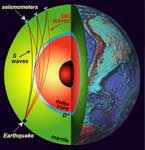 |
Seismologists use many different seismic waves to study Earth's interior. In this image,
the waves S and SKS are shown. When one wave is studied and then
compared to the other, information of the deep interior can be infered for the
regions where the wavepaths depart. This particular phase pair is useful
for studying the very base of the mantle, the D" region. |


















